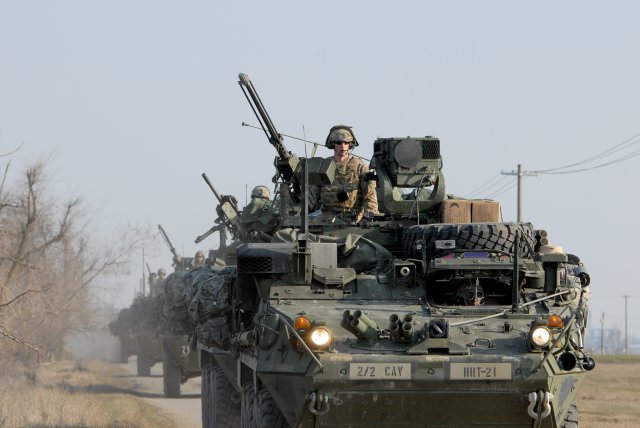The 30 Millimeter Solution: Army Upgunning Strykers Vs. Russia
Posted on

Stryker vehicles from the Army’s 2nd Cavalry Regiment in Romania.
Amidst rising anxieties over Russia, one of the last US combat units still based in Europe, the 2nd Cavalry Regiment, has asked for bigger guns. The House Armed Services Committee is already setting aside money for the urgent upgrade, which the Army staff officially approved yesterday in a memo obtained by Breaking Defense:
In brief, the 2nd Cavalry wants 81 of its eight-wheel-drive Stryker infantry carrier vehicles fitted with 30 millimeter automatic cannon. 30 mm is more than twice the caliber of the 12.7 mm machineguns those Strykers currently mount. It’s actually a bigger weapon than the notoriously destructive 25 mm chaingun on the much heavier M2 Bradley infantry carrier.
Adding a 30 mm weapon won’t make Strykers into tanks: An M1 Abrams’ main gun is a whopping 120 mm. But there are physical limits on what a 20-30 ton wheeled vehicle can accommodate. The Army spent years trying to fit a 105 mm cannon on a Stryker chassis, the Mobile Gun System (MGS). By contrast, 30 mm is a manageable size that would give the Strykers significant killing power against other light armored vehicles, such as Russian BMPs.
“MGS was a failure, which is why they stopped producing them,” one Hill staffer told me. “That said, MGS is better than nothing in terms of fire support. These [proposed] 30mm remote weapon stations help quite a bit.”
The 2nd Cavalry wants the weapons because it’s the Army’s frontline force in Europe. There are only two US combat brigades still based on the continent, the 2nd Cav in Vilseck, Germany and the 173rd Airborne in Vicenza, Italy, a light infantry formation with very few vehicles of any kind and nothing as heavy as a Stryker. The Army has no heavy tank forces permanently stationed in Europe anymore, which the House Armed Services Committee has decried as “short-sighted.”
Since Russia seized Crimea, both the 2nd Cavalry and the 173rd Airborne have deployed to the Baltic States to deter aggression and reassure those small, exposed NATO allies. (The 173rd has even trained some Ukrainian forces). Just a month ago, a 60-Stryker task force of the 2nd Cavalry conducted an 1,100-plus mile “dragoon ride” back from the Baltics to Germany by way of Poland and the Czech Republic. The maneuver showed off the Stryker vehicles’ impressive mobility: As wheeled vehicles, they do better on long road marches than tracked tanks, although their performance is worse off-road. But clearly the Army thought they were lacking in lethality — and that’s what this upgrade is intended to correct.
The bigger question: Will the Army stop at upgrading 81 vehicles in Europe, or will it eventually seek funding to install the 30 mm weapons on Strykers in other theaters such as the Pacific. The memo pledges that the powerful Training and Doctrine Command (TRADOC) will study “potential application… across the broader Stryker force.” With the national strategy emphasizing crisis response and “expeditionary” forces, the Army is increasingly looking for armored vehicles light enough to rapidly deploy by air — but still heavily armed enough to fight on arrival.
Subscribe to our newsletter
Promotions, new products and sales. Directly to your inbox.
